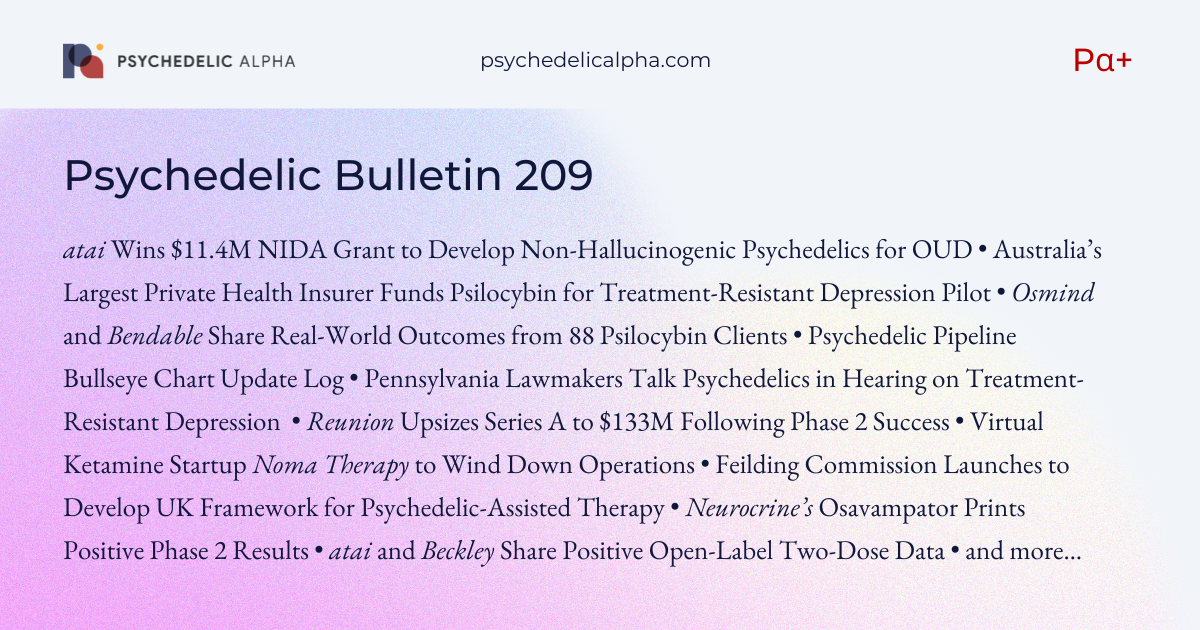In this Issue
- atai Wins $11.4M NIDA Grant to Develop Non-Hallucinogenic Psychedelics for OUD
- Australia’s Largest Private Health Insurer Funds Psilocybin for Treatment-Resistant Depression Pilot
- Osmind and Bendable Share Real-World Outcomes from 88 Psilocybin Clients
- Psychedelic Pipeline Bullseye Chart Update Log
- Pennsylvania Lawmakers Talk Psychedelics in Hearing on Treatment-Resistant Depression
- Reunion Upsizes Series A to $133M Following Phase 2 Success
- Virtual Ketamine Startup Noma Therapy to Wind Down Operations
- Feilding Commission Launches to Develop UK Framework for Psychedelic-Assisted Therapy
- Neurocrine’s Osavampator Prints Positive Phase 2 Results
- atai and Beckley Share Positive Open-Label Two-Dose Data
- and more…
***
We forgo our introductory remarks today, as it’s been a busy couple of weeks since we published our last Bulletin, so there is plenty to dive into in this Issue…
***
atai Wins $11.4M NIDA Grant to Develop Non-Hallucinogenic Psychedelics for OUD
Last week, atai Life Sciences announced that it has been awarded a UG3/UGH grant[1] from the U.S. National Institute on Drug Abuse (NIDA), which is part of the National Institutes of Health (NIH), to optimise and develop a suite of non-hallucinogenic 5-HT2A/2C receptor agonists for opioid use disorder (OUD).
An entry in NIH’s RePORTER database provides further detail. Leads in the program include EGX-J and EGX-I, which the company says “exhibited non-hallucinogenic potential and engaged their targets in a manner reflective of the polypharmacology of psilocybin”, at least in early non-clinical studies. It also emphasises low activity at the 5-HT2B receptor, which it notes has been linked with potential cardiovascular toxicity.
While the first tranche is just shy of $3M, the company says that the combined award would be worth up to $11.4M over the course of five years, should it meet milestones.
That non-dilutive funding could catalyse the program, supporting lead optimisation, proof-of-concept studies, and other IND-enabling efforts like toxicology and manufacturing work.
It also means that atai has the firepower to meaningfully begin developing non-hallucinogenic candidates in-house, something that other mid- to late-stage psychedelic drug developers have struggled to do, with a more challenging funding environment causing developers to narrow their focus on psychedelic lead candidates.
This news comes as some standalone non-hallucinogenic psychedelics companies appear to be wavering. There has been little news of late from one of the niche’s most prominent companies, Delix Therapeutics. The non-hallucinogenic drug developer’s CSO, Kurt Rasmussen, also departed earlier this year, and does not appear to have been replaced.
Gilgamesh Pharmaceuticals, however, is another outfit that is developing both hallucinogenic and non-hallucinogenic compounds. As we reported last March, the privately-held company has also received NIDA funding to develop an OUD treatment, to the tune of $14M. In fact, it secured the award from the very same funding call as atai (PAR-22-200).
But there are differences: Gilgamesh’s NIDA funding was attached to its development of a ‘safer ibogaine analog’, which is certainly psychoactive, while atai’s NIDA funding supports the development of non-hallucinogenic candidates. And, while Gilgamesh…
Sign-in or join Pα+ to continue reading this Issue of the Psychedelic Bulletin…
Join Pα+ Today
Independent data-driven reporting, analysis and commentary on the psychedelics space: from business and drug development through to policy reform and culture.
Already a member? Log In
✓ Regular Bulletins covering key topics and trends in the psychedelics space
✓ Regular articles and deep dives across psychedelic research, policy and business
✓ Interviews with insiders
✓ Monthly interactive database and commentary on psychedelic patents
✓ Quick-take analysis of major developments
✓ A Library of primers and explainers
✓ Access to our full back catalogue


